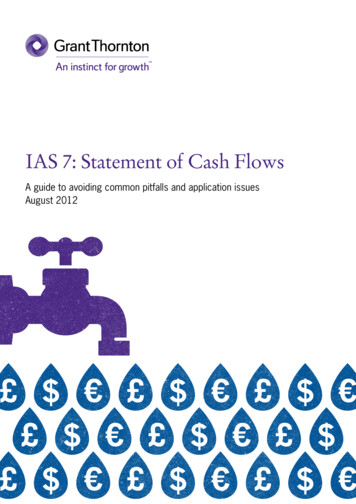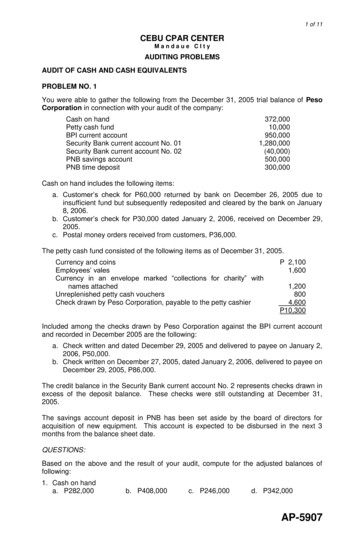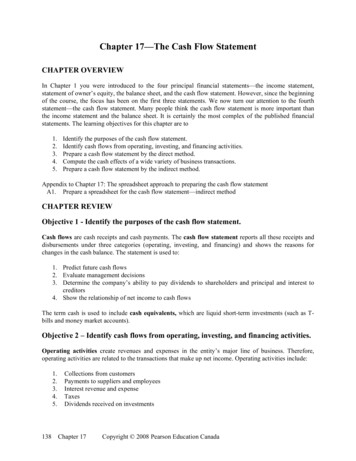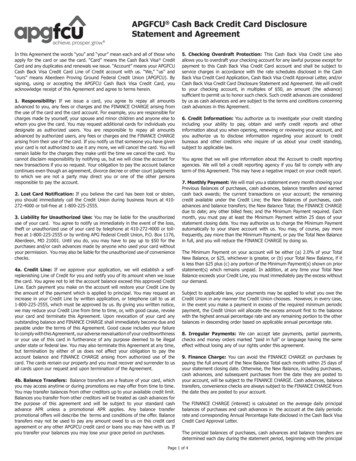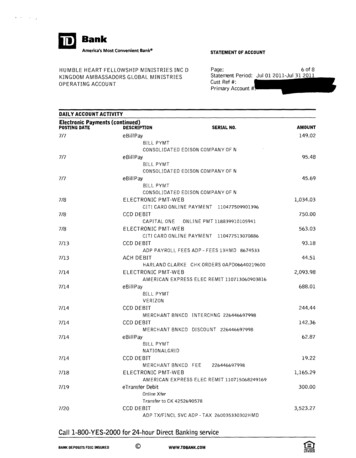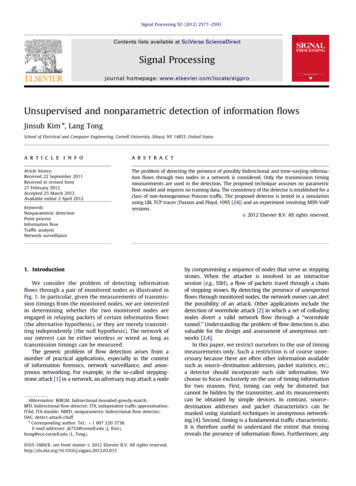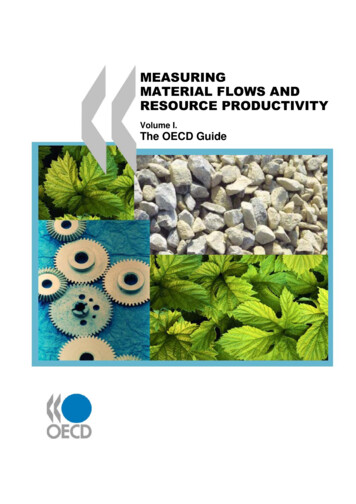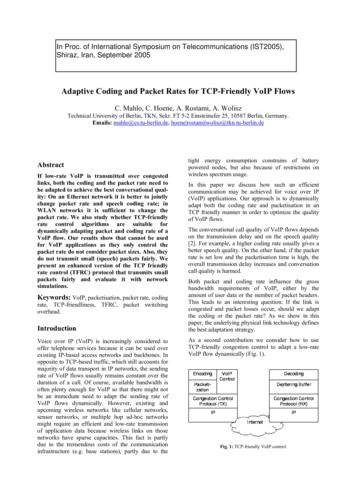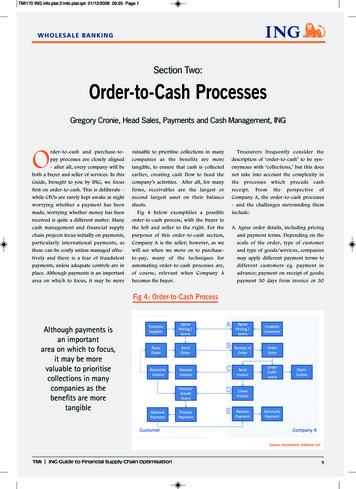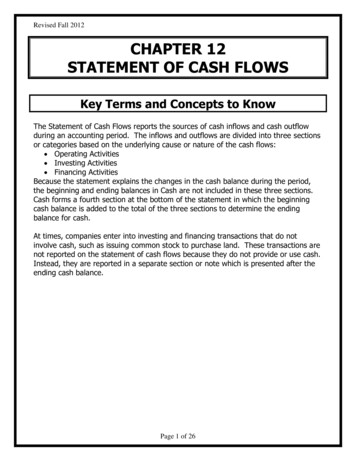
Transcription
Revised Fall 2012CHAPTER 12STATEMENT OF CASH FLOWSKey Terms and Concepts to KnowThe Statement of Cash Flows reports the sources of cash inflows and cash outflowduring an accounting period. The inflows and outflows are divided into three sectionsor categories based on the underlying cause or nature of the cash flows: Operating Activities Investing Activities Financing ActivitiesBecause the statement explains the changes in the cash balance during the period,the beginning and ending balances in Cash are not included in these three sections.Cash forms a fourth section at the bottom of the statement in which the beginningcash balance is added to the total of the three sections to determine the endingbalance for cash.At times, companies enter into investing and financing transactions that do notinvolve cash, such as issuing common stock to purchase land. These transactions arenot reported on the statement of cash flows because they do not provide or use cash.Instead, they are reported in a separate section or note which is presented after theending cash balance.Page 1 of 26
Revised Fall 2012Key Topics to KnowThe statement of cash flows explains the changes in the balance sheet during anaccounting period from the perspective of how these changes affect cash. As notedabove, the cash inflows and outflows are divided into three sections plus a cashsection based on the balance sheet accounts underlying the cause or nature of thecash flows. Investing and financing activities that do not involve cash are presentedin a separate schedule.Cash Flow Statement SectionBalance Sheet AccountsOperating ActivitiesNet Income revenue – expensesCurrent assets excluding cashCurrent liabilities excluding dividendspayable and short-term notes payableInvesting ActivitiesNon-current assetsFinancing ActivitiesLong-term liabilitiesShort-term notes payableCapital stock and treasury stockDividends declared and dividends payableCashCashNon-cash Investing andFinancing ActivitiesChanges in long-term liabilities, shortterm notes payable, capital stock andtreasury stock that do not involve cashPractice Problem #1Identify which section of the statement of cash flows each of the following eventswould appear in (operating, investing and financing or in a separate schedule):a)b)c)d)e)f)g)h)i)j)Purchased a PatentSold Treasury stockNet IncomeSold long-term investmentsPurchased a buildingIssued bonds.Paid dividendsRecorded depreciation expense for the yearIssued common stock to retire a mortgagePurchased treasury stockPage 2 of 26
Revised Fall 2012Operating ActivitiesOperating Activities include the events and transactions that determine day-todayoperating activities. These events and transactions include net income and thechanges in the current asset and current liability accounts related to net income.Those transactions and events that do not provide or use cash are excluded fromdetermining cash flows from operating activities.For example, sales on account are used to determine net income, but to the extentthat these sales remain uncollected at the end of the period, the increase in accountsreceivable is not a cash flow and must be deducted when converting net income intocash flow from operating activities.Examples of non-cash transactions include depreciation, depletion and amortizationexpense and gains and losses from the sale of plant assets and the retirement ofbonds.There are two methods of preparing the operating activities section: Indirect Methodand Direct Method. Both methods calculate the same total of cash flows fromoperating activities, although the methodologies are considerably different.Indirect MethodThe indirect method starts with net income and adjusts it for non-cash transactionsand other cash used by or provided by normal daily activities.Net IncomeAdd:Noncash expenses (i.e., depreciation and amortization)Losses on sales or retirementsDecreases in Current AssetsIncreases in Current Liabilities related to operations*Deduct: Increases in Current AssetsDecreases in Current Liabilities related to operations*Gains on sales or retirements Net Cash Flows from Operating Activities*Note that changes in non-operating current liabilities are included elsewhere on thestatement. For example, changes in dividends payable are combined the dividendsdeclared to calculate dividends paid in the financing section.Page 3 of 26
Revised Fall 2012Example #1Given the following information and using the indirect method prepare the Cash Flowsfrom Operating Activities section of the statement of cash flows.CashAccounts receivable (net)InventoriesPrepaid expensesAccounts payable (creditors)Salaries PayableEnd of Year 23,50084,500100,2004,97071,4005,320Beginning ofYear 1505,900(330)2,500(1,130)Net Income reported on the income statement for the current year was 134,800.Depreciation expense recorded on buildings and equipment was 27,400 for the year.Solution #1Net IncomeAdd:Decrease in prepaid expensesIncrease in Accounts PayableDepreciation ExpenseDeduct:Increase in Accounts ReceivableIncrease in InventoriesDecrease in Salaries PayableNet Cash Flows from Operating ActivitiesPage 4 of 26 3302,50027,400 4,1505,9001,130 134,80030,230165,03011,180 153,850
Revised Fall 2012Practice Problem #2Given the following information and using the indirect method prepare the Cash Flowsfrom Operating Activities section of the statement of cash flows.CashAccounts ReceivableMerchandise InventoryPrepaid ExpensesAccounts Payable (creditors)Wages PayableEnd of Year 345,000554,300693,00027,000510,00039,500Beginning ofYear 386,000567,800672,40024,000527,40036,000The net income reported on the income statement for the current year was 465,000,which included a gain on sale of investments of 3,000. Depreciation expenserecorded on store equipment for the year amounted to 99,800.Direct MethodThe direct method starts with the entire accrual-basis income statement (not just netincome) and converts it line-by-line to the cash basis. The resulting cash inflows andoutflows are the cash flows used by or provided by normal daily activities. Forexample, accrual-basis sales are converted to cash collected from customers byadding the decrease or deducting the increase in trade accounts receivable.The direct method is preferred by the FASB as it provides more useful information theusers of the financial statements. The FASB requires that, if the direct method isused, that a reconciliation of net income to net cash provided or used by operatingactivities be provided in the footnotes or as part of the statement. This reconciliationfrequently looks quite similar to the cash flow from operating activities sectionprepared using the indirect method.Page 5 of 26
Revised Fall 2012The operating activities section prepared using the direct method would appear asfollows:Cash received from customers:oSales ( decrease in A/R OR -increase in A/R)Less: payments to creditors and for expensesoCost of Merchandise Sold increase in inventories OR -decrease in inventories decrease in A/P OR -increase in A/PoOperating Expenses decrease in accrued expenses OR -increase in accrued expensesoInterest Expense decrease in interest payable OR -increase in interest payableoIncome Tax Expense decrease in income tax payable OR -increase in income tax payable Net Cash Flows from Operating ActivitiesInvesting ActivitiesInvesting Activities include events and transactions that affect long-term assets.For example, the journal entry to record the sale of land with a cost of 100,000 for 120,000 would be:Cash120,000LandGain on sale100,00020,000The effect of this transaction is to reduce long-term assets by 100,000. On thestatement of cash flows, the cash proceeds are reported as an inflow in the investingactivities section and the gain is deducted from net income in the operating activitiessection as noted above.If equipment is purchased for 75,000, the journal entry would be:EquipmentCash75,00075,000The 75,000 would be reported as a use of cash in the investing section.Page 6 of 26
Revised Fall 2012The Investing Activities section would appear as follows:Cash inflows from:Sale of Long-term Assetso Property, Plant or Equipmento Intangible assetso InvestmentsLess: Cash outflows from:Purchase of Long-term Assetso Property, Plant or Equipmento Intangible assetso Investments Net Cash Flows from Investing ActivitiesExample #2Given the following selected information, determine the net cash flows from investingactivities and the net cash flows from financing activities:a) Net income was 189,500 for the period.b) Purchased 10,000 shares of common stock at 15 per share for the treasury.c) Sold equipment with a carrying value of 32,500 at a gain of 6,000.d) Purchased land and a building worth 450,000 by signing a ten-year notepayable.e) Issued 1,000,000 in bonds at par.f) The beginning and ending retained earnings account balances were 418,000and 534,000, respectively. There were no prior period adjustments during theperiod.g) Wrote a check for 648,000 for the purchase of machinery.h) Sold long-term investments in marketable securities with a 50,000 carryingvalue, at a loss of 17,500.i) Cash dividends were declared and paid during the period.Solution #2Investing ActivitiesCash received from sale of equipment 32,000 – 6,000 Cash received from sale of investments 50,000 – 17,500 Cash paid for machineryNet cash flows from investing activitiesPage 7 of 26 38,50032,500(648,000)( 577,000)
Revised Fall 2012Financing ActivitiesFinancing Activities include events and transactions that affect long-term liabilities andequity other than net income.For example, the journal entry to record the issuance of bonds with a face value of 100,000 would be:Cash100,000Bonds payable100,000The effect of this transaction is to increase long-term liabilities by 100,000. On thestatement of cash flows, the cash proceeds are reported as an inflow in the financingactivities section.If the bonds are subsequently retired at 101, the journal entry would beLoss on retirementBonds payableCash1,000100,000101,000The effect of this transaction is to reduce long-term liabilities by 100,000. On thestatement of cash flows, the cash spent is reported as an outflow in the financingactivities section and the loss is added to net income in the operating activities sectionas noted above.Dividends paid are also included in the financing activities section. Dividends paid arenot part of the operating activities section because dividends do not appear in theincome statement. They are reported in the financing activities section because theyrelate to the equity section of the balance sheet and cash flows from changes inequity are reported in this section.Whenever the beginning balance does not equal the ending balance for dividendspayable, the dividends paid will have to be calculated using the following formula:beginningbalance dividendsdeclared-endingbalance dividendspaidIf the beginning balance equals the ending balance for dividends payable or there areno beginning and ending balances for dividends payable, then the dividends paidequals the dividends declared.Page 8 of 26
Revised Fall 2012The Investing Activities section would appear as follows:Cash inflows from:Issuing debt or equity securitieso Issuing bondso Issuing Stocks (Common and Preferred)o Reissuing Treasury Stockso Issuing other long-term debts (mortgage payable, notes payable)Less: Cash outflows from:Retiring debts, repurchasing equity securities and paying dividendso Payments to retire bondso Payments to retire other long-term debtso Payments for Dividendso Payments to purchase Treasury Stock Net Cash Flows from Financing ActivitiesAgain, Non-cash Financing and Investing Activities, such as issuing stock to retirebonds, are reported in a separate schedule that appears after the bottom of theStatement of Cash Flows.Example #3Given the following selected information, determine the net cash flows from investingactivities and the net cash flows from financing activities:a) Net income was 189,500 for the period.b) Purchased 10,000 shares of common stock at 15 per share for the treasury.c) Sold equipment with a carrying value of 32,500 at a gain of 6,000.d) Purchased land and a building worth 450,000 by signing a ten-year notepayable.e) Issued 1,000,000 in bonds at par.f) The beginning and ending retained earnings account balances were 418,000and 534,000, respectively. There were no prior period adjustments during theperiod.g) Wrote a check for 648,000 for the purchase of machinery.h) Sold long-term investments in marketable securities with a 50,000 carryingvalue, at a loss of 17,500.i) Cash dividends were declared and paid during the period.Page 9 of 26
Revised Fall 2012Solution #3Financing ActivitiesCash paid to purchase treasury stock10,000 shares x 15 Cash received from sale of bondsCash paid for dividends 418,000 189,500 - 534,000 Net cash flows from financing activities( 150,000)1,000,000(73,500) 776,500Practice Problem #3For each of the following situations indicate the items to be reported on the statementof cash flows, the section of the statement in which the item would appear and theamount.a)b)c)d)e)f)g)The board of directors declared cash dividends totaling 240,000 duringthe current year. The comparative balance sheet indicates dividendspayable of 50,000 at the beginning of the year and 60,000 at the endof the year.Office equipment, which had cost 245,000 and on which accumulateddepreciation totaled 95,000 on the date of sale, was sold for 130,000during the year.Delivery equipment, which had cost 39,000 and on which accumulateddepreciation totaled 23,000 on the date of sale, was sold for 20,000during the year.The company issued 5,000 shares of 10 par Common Stock for 50 pershare.The company purchased land with a mortgage note payable.Depreciation expense reported on the income statement was 55,
Bonds payable 100,000 The effect of this transaction is to increase long-term liabilities by 100,000. On the statement of cash flows, the cash proceeds are reported as an inflow in the financing activities section. If the bonds are subsequently retired at 101, the journal entry would be Loss on retirement 1,000 Bonds payable 100,000
